|
|
| Just where, when and how Omsk was founded |
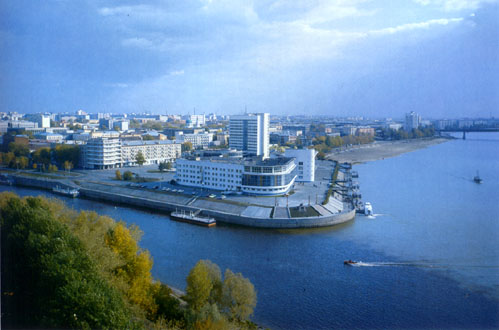 The spit – the place where Omsk was founded. The spit – the place where Omsk was founded.
Omsk was founded in 1716, just a few years after Saint-Petersburg. |
|
 Kolchak’s house Kolchak’s house
The Batushkin’s mansion – a memorial of history and architecture. It’s situated in the centre of Omsk at the bank of Irtysh river, near the hotel “Tourist”. It was built in 1901-02 for a merchant Batushkin.
The mansion hosted the ministry of supply and provisions of the Temporary All-Russian government (minister Serebrynnikov).
This is also the house where the famous admiral Kolchak lived during his stay in Omsk – 15th of December, 1918 – 12th of November, 1919.
Many very important events in the life of Kolchak are connected with this place. His proclamation that he was the “Ruler of Russia”, gaining of the “Tsar’s gold”, his last love, his last hope and his last defeat…
|
|
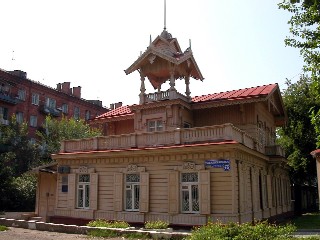 Kondraty Belov’s museum Kondraty Belov’s museum
Chohan Valikhanov street is rich in old beautiful buildings but the most outstanding of them is that of Kondraty Belov’s museum. Before the revolution of 1917 probably the most prominent industrialist of Omsk Stumpf lived here.
Now it is a monument of wooden architecture. But apart from the architecture, this house contains a good collection of the works of one of the best Siberian painters Kondraty Belov. He used to work in this house and this place still retains an echo of his presence here. In the evenings the museum turns into a musical - poetical drawing-room.
|
|
| The Cossak military church |
 The Cossack Nikolsky Cathedral The Cossack Nikolsky Cathedral
The most eminent cult building of Omsk. Here the banner of Ermak, legendary pioneer of Siberia and the first Russian to start its exploration on a grand scale, was kept. Unfortunately the banner disappeared when Kolchak’s troops were leaving the city. However, the communists didn’t blow it up but instead used it at first as a warehouse and then an organ hall. During the 90-es the building was returned to the Russian Orthodox Church. The cathedral is surrounded by a small but pretty park.
|
|
 Omsk Military School Omsk Military School
The Military School is right in front of the Cathedral. After its restoration in the autumn of 2003 it looks splendid. This building, also designed in the classic style, turned out many very famous military men such as general Kornilov, general Karbyshev and others. Here Kolchak had his most faithful supporters among the cadets. With the rest of Kolchak’s troops the school moved to Vladivostok, Shanghai and Yugoslavia, where it was finally abolished. And still in Paris cemeteries there are graves with the symbol ‘A-1’ which means that the deceased graduated from the Omsk Military School of Alexander the First. The revival of the school is connected with the governor of Omsk region, Leonid Polezhaev, who managed to restore it and returned to the school its former building.
|
|
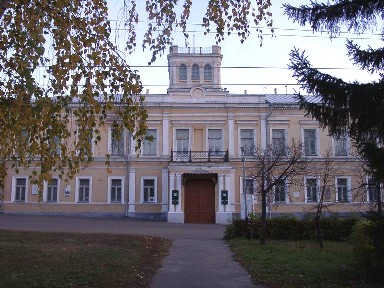 Governor-general palace. Governor-general palace.
This marvelous building is also very interesting from a historical point of view. Built in 1862 on the request of Governor General Gasford, it was prepared to accommodate the emperor of Russia in case he arrived in Omsk. Many very famous people visited the palace – traveler Prezhevalsky, zoologist Brem and even Nikolay the Second was here before his coronation. After the revolution of Februrary 1917, the palace was claimed to be a property of the state and renamed as “The house of Republic”. The Council of workers’ and soldiers’ delegates as well as the so-called “cheka” (political police of communist government) worked here. In 1918-1919 as the communist were pushed out from the city, the Temporary All-Russian government and Supreme Ruler of Russia Kolchak worked here. In 1924 the building was given to the museum of local lore, history and economy.
|
|
| Who was Lenin? Why he hated Russia so much!!! |
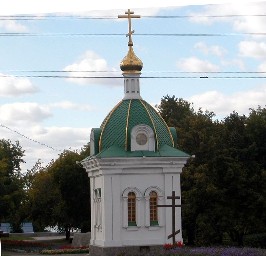 Hillock Iliinskaya Hillock Iliinskaya
From the Palace of the Governor General passing through a square you can reach the place where the Iliinskaya Church stood. After the revolution it was blown up and replaced by a monument of Lenin. Unlike many other sculptures of Lenin, this one doesn’t point the way of communism but stands as if thinking “What have we done!”. Behind the monument there is a chapel put here in the hope that some day the church will be rebuild. What is interesting that it took only 6 hours to build this chapel!
|
|
| May be one of the most beautiful chapels |
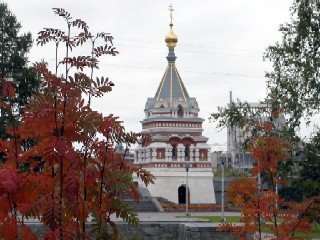 Chapel Serafimo-Alekseevskaya Chapel Serafimo-Alekseevskaya
Passing the bridge near the Iliinskaya chapel you approach one of the main symbols of Omsk – chapel Serafimo-Alekseevskaya built on the occasion of birth of crown prince Alexiy, the son of the last Russian emperor Nikolay the Second. It was one of the first victims of the Bolsheviks’ war on the church and one of the first chapels to be restored at the beginning of 90s. You may cross the street towards “Oktyabrskaya” hotel (former name Hotel Rossiya) and visit cafe “Solo” for a cup of coffee and a rest. Next to “Solo” there is the Omsk Organ Hall. The acoustics in this building are great and you can often hear concerts by famous Omsk and Russian performers here including the “golden voice” of Omsk Svetlana Borodina. After the cafe if you follow this street to the first junction and then turn right you will find a small corner of old Omsk!
|
|
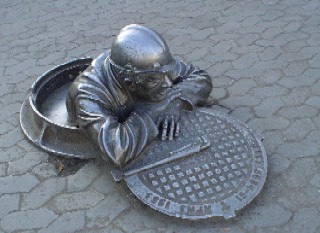 Plumber Stepan Plumber Stepan
Following Karl Liebknecht street and admiring the old buildings which used to be the base of many foreign representatives in Omsk you will suddenly see a plumber looking at you from the sewer well. This is a monument to all people who work in the city to make life comfortable for us and whose work we often tend not to mention. Very soon after this sculpture was installed it was given the nickname “Stepan”.
|
|
 Lyuba. Lyubochka, Lyubasha. Lyuba. Lyubochka, Lyubasha.
Across the Lyubinsky avenue Stepan constantly watches a young lady sitting on a bench. There is a belief that if a visitor wants to return to Omsk one day, he should sit on a bench with this young lady for a while. Her story is a sad and touching one. Once upon a time in Omsk there lived an old German Governor General. And he married a young and beautiful Siberian girl – Lyuba. But soon their happiness was over. Lyuba caught consumption and would often sit on a bench warming herself in the sun. So she still sits there and people walking on Lyubinsky avenue sometimes have their photoes taken with her or even bring her flowers. And everyone addresses her in his own endearing way – Lyuba, Lyubochka, Lyubasha.
|
|
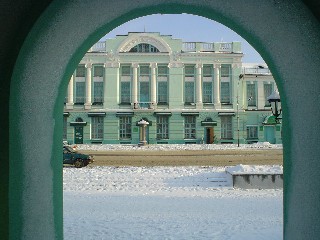 The Vrubel Museum of Fine Arts The Vrubel Museum of Fine Arts
On your way to the museum you will approach a chapel on a hill. Take a look around, you are in one of the most beautiful streets of Omsk. Across the road there is the building of the former women’s school - our answer to St. Peters Smolny Institute. The present building of the Vrubel Museum of Fine Arts was built in 1914 as a trading center. And still it is possible to see Mercury – the god of trade on the facade.
Omsk Regional Museum of Fine Arts in the name of Mikhail Aleksandrovich Vrubel was founded in 1924 when a picture gallery was opened as a part of West Siberian Local Museum. In 1940 it became an independant museum of fine arts. Since 1996 the museum bears the name of Vrubel, a great Russian painter who was born in Omsk in 1856. This is the only museum in the eastern part of Russia which holds the works by this master.
Nowadays the museum holds the biggest collection in Siberia. It includes about 22 000 items, among which are:
The works of Western Europeen painters – Tenirs, Lampy, Grez; icons of Russian masters dating from XVII to XX century; the works of Russian painters representing different trends of art – Aivazovsky, Repin, Surikov, Levitan, Serov, Goncharov, Konchalovsky, Mashkov, Mamontov e.t.c. The collections of gold articles dating to skif-sarmat epoque are also of a great interest as they are rare to see in Siberian museums.
The museum occupies 2 buildings – the palace of the Governor General palace (1859-1862, built by Vagner) and the City Trading Centre (1911 -1914, built by Kryachkov) which was given to the museum in 1996. Before the revolution, there was a restaurant with its own orchestra in this building. That is why its good acoustics are used for different concerts.
|
|
| Where people meet each other to see something great |
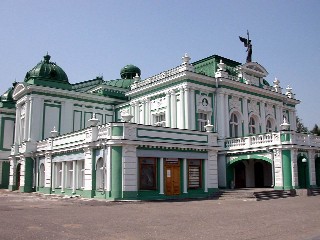 Omsk Drama Theatre Omsk Drama Theatre
Omsk Drama theatre is probably the most beautiful building of the city and it’s no wonder that the citizens of Omsk take pride in it. If you want to visit it you’d better book tickets in advance! It’s also the 4th oldest theatre of Russia after Moscow, Saint-Petersburg and Yaroslavl. The theatre’s company is also worth mentioning as it is often nominated in different theatre festivals. On the right from the theatre is a very interesting sculpture of Dostoevsky. Taking Lenin street you can walk from the theatre to the Pioneers Square.
|
|
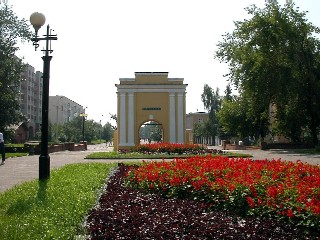 Tara Gate Tara Gate
This gate used to be the north gate of the city and its fortress. In 1959 it was destroyed but soon in 1991 it was restored. You can go through it to the remains of the old fortress.
There is a strong belief among the Omskovites that if you hop therough the gate and do not fall - your wish will be fulfilled. Try this.
This is also the spot in Omsk where the young-wed assemble to celebrate their marriage. Some girls are beautiful some not, but it is interesting to watch them all.
Then you proceed the the Dome square. In 2003 the sculpture of marathon runner was installed here symbolizing one of the most important events in sporting life of Omsk – the Annual Siberian International Marathon (SIM) which attracts thousands of participants from all parts of Russia and other countries.
But of course the main attraction of the square is the Dome of Omsk.
Near the square there are the buildings of the Regional Parliament, Regional Government.
|
|
 Before the Bolsheviks came to power, Omsk had the Center - the Omsk Dome and the nearby square. It was one of the most beautiful churches in Russia. But the Barbarians had no mercey and it was destroyed in the 30-ies. So, Omsk lost its Center. Before the Bolsheviks came to power, Omsk had the Center - the Omsk Dome and the nearby square. It was one of the most beautiful churches in Russia. But the Barbarians had no mercey and it was destroyed in the 30-ies. So, Omsk lost its Center.
The Communists tried to fill in the gap, and made out of it an amusement square with a fountain and slides in winter.
It is only in the new millenium that Omsk had got its Center back. The Dome is reconstructed strictly according to the original.
To be sure it is again one of the most beautiful churches in Russia!
Near the Dome there are some interesting things to see.
It is great that all these: a deer, which people tie ribbons to by a Buddhist tradition, sculpture of a boy and a girl with fish (which is known by Omsk residents since 1960s), and the marathoner monument itself- exist in harmony after the reconstruction of the Cathedral.
The place itself is just wonderful. All is beautiful and well-attended. In any season it is interesting to watch the sunset here.
|
|
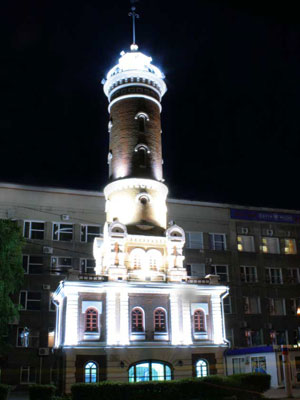 An unusual building of cylindrical form is well within view from the points of the drama theatre and the museum. An unusual building of cylindrical form is well within view from the points of the drama theatre and the museum.
A fire-lookout tower is a very interesting example of the old architecture. Perhaps, in the past there were many of suchlike buildings, but nowadays the tower looks out of the ordinary. Firemen used to watch glows of a distant fire from the tower, in commemoration of this fact a full-size model of a fireman was assembled at the top of the tower.
There is a “zero post” of Omsk region near the fire-lookout tower, just in front of the entrance to the central post office. An underground passage parts the tower from the building of “Omsky” shopping centre, during the soviet period it took 10 years to build it, but it came out not bad for those days.
|
|
| Standing on the corner watching all the girls passing by |
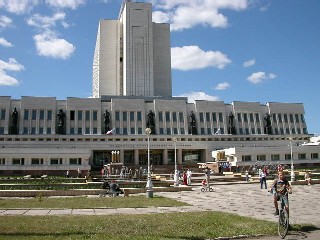 Pushkin Library Pushkin Library
If you stop near the library and take a look around you will immediately understand why citizens of Omsk are sure that the most beautiful women in the world live here in Omsk. The most “female” universities of Omsk – the pedagogical and technological - are not far from this place. And the building of the library is also very beautiful, in the beginning of 90s it received a prize from prominent Swiss organization for splendid design.
|
|
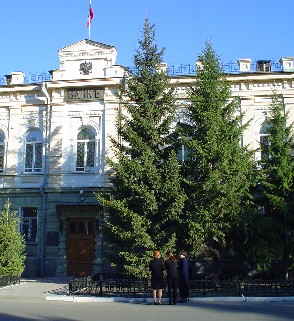 A riddle to the present day A riddle to the present day
At the beginning of WW I Russia possessed one of the biggest gold reserves in the world. It amounted to 1337.9 tons by the year 1915. As the Civil War began in Russia the gold reserve was moved to Omsk, proclaimed the capital of Russia in 1918-1919.
Admiral Kolchak was proclaimed the “Ruler of Russia”. He took the tsar gold under strict control. The entire value of golden jewelry and gold ingots, which turned to be at Kolchak administration disposal, was 651532117 roubles. In November Kolchak and his government had to leave Omsk and set off for Irkutsk. Retreating, they managed to take tsar gold with them though the danger to be encircled was real and there was consternation and confusion among the soldiers.
Still in Omsk to see is the bank were the gold was kept!
|
|
| Tobolsk gates and the second Omsk fortress |
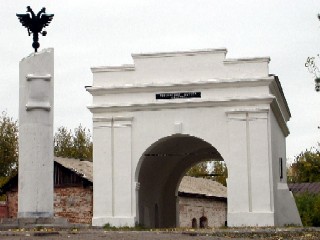 The Tobolsk Gate The Tobolsk Gate
Omsk fortress continued its existing till the middle of the 19th century, having played an important role in the history of Siberia and Kazakhstan.
|
|
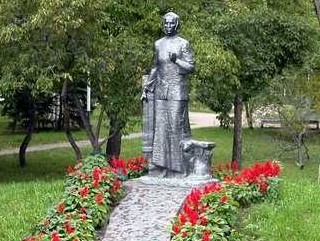 Monument of Mother and World War II Museum Monument of Mother and World War II Museum
On the territory of the old fortress you can find the Museum of the Second World War. The collections of this museum represent different periods of this war and trace the destines of Omsk citizens who took part in this war. In the yard of the museum there are many cannons, tanks and self-propelled guns that the Soviet army used in that war. Even the famous missile launcher “Katyusha” is represented in collection. In front of the museum stands a statue of a simple Siberian woman who lost all her seven sons during this war. However this monument is devoted not only to her but also to all other Russian women who lost their nearest and dearest during this awful war.
|
|
| Dostoevsky and Lutheran church |
 Dostoevsky Museum Dostoevsky Museum
The Dostoevsky museum does not have such a rich collection as the one in Saint-Petersburg but here you can feel the real spirit of Dostoevsky. Omsk is a place where the writer experienced an abyss of despair, of moral and physical sufferings. His road to fame started here. The museum building was created in 1799 as a house of commandant for the fortress. Commandant De Grave did his best to help the writer in his exile and he received him many times at home. Later Dostoevsky said that in De Grave’s family “he was treated like equal”.
Lutheran Church
Since the day of its foundation Omsk has been a place where different religions co-exist in peace. Orthodox Russians, Muslims, Jews and Catholics has no need to argue on religious grounds. That’s why in 1792 on the territory of the fortress a very beautiful Lutheran church has been built. At the moment this building is occupied by the militia museum.
Interesting fact:
at the end of August the city organizes “Flora”- an exhibition of flowers, vegetables and fruits and this event covers the nearby park in most vivid colours of fresh flowers and plants.
|
|
 The organ hall was opened in the building of The Cossack Nikolsky Cathedral in 1983. This helped to prevent this building from destruction. The famous Czech company “Riger Closs” made an instrument consisting of 3700 pipes which was called “Opus 504”. There are no more than 50 organs in Russia and Omsk organ is regarded as one of the best among them. Many very famous musicians performed in Omsk organ hall – Harry Grotberg, Oleg Yanchenko, soloists Dmitry Khvorostovsky, Maria Bieshu. The organ hall was opened in the building of The Cossack Nikolsky Cathedral in 1983. This helped to prevent this building from destruction. The famous Czech company “Riger Closs” made an instrument consisting of 3700 pipes which was called “Opus 504”. There are no more than 50 organs in Russia and Omsk organ is regarded as one of the best among them. Many very famous musicians performed in Omsk organ hall – Harry Grotberg, Oleg Yanchenko, soloists Dmitry Khvorostovsky, Maria Bieshu.
However in 1990 it was decided to return the building to the Russian Orthodox Church and it was clear that the traditional Catholic musical instrument cannot remain in the Orthodox cathedral.
So in 1998 the organ was dismantled and all pipes were put in specially-made boxes and transported to the building of the former “Khudozhestvennyi” cinema. Here, the specialists assembled and tuned. About 6 tons of broken glass items were put in the walls to improve accoustics. The experts of “Riger Closs” company praised the condition and the quality of Omsk organ after its journey to a new hall.
The transfer of an organ from one hall to another is an unique operation never done before or after this. Organs compose an unity with halls, moreover, they are designed specially for these halls, and it’s the case with Omsk organ.
“The second birth” of Omsk organ took place during the celebrations of the 286th anniversary of Omsk city, on July 30, 2002.
The experts say that the organ sounds as well as it did in its former building. The organ sounds the best when the echo of its sound lasts for about 3 seconds and Omsk organ corresponds perfectly to this demand. The information about the wonderful transfer of Omsk organ quickly spread over the Internet. People all over the world got intrested and expressed the desire to listen to this “wonder”. And now everyone is welcome to enter the incredible world of organ music.
|
|
| Another beautiful building |
 The building of court establishments is situated in the centre of the city, near Bankovsky lane and Alekseeva street (former Sobornaya square). It was built according to the academician Prusakov’s project. The construction began in 1916 (at the same time the monument to the tsar Alexander the III, who undertook the judicial reform, was laid nearby) and lasted for 3 years. The building was supposed to host different legal institutes but it was hardly ever used for that. Only in 1919 the Ministry of Justice of the Temporary All-Russian government and the Senat worked here. During the Soviet era it was used by Siberian Revolutionary Commitee (the Supreme govermental body in Siberia) and other Soviet and communistic institutions. Presently this is the building of the Regional parliament. The building of court establishments is situated in the centre of the city, near Bankovsky lane and Alekseeva street (former Sobornaya square). It was built according to the academician Prusakov’s project. The construction began in 1916 (at the same time the monument to the tsar Alexander the III, who undertook the judicial reform, was laid nearby) and lasted for 3 years. The building was supposed to host different legal institutes but it was hardly ever used for that. Only in 1919 the Ministry of Justice of the Temporary All-Russian government and the Senat worked here. During the Soviet era it was used by Siberian Revolutionary Commitee (the Supreme govermental body in Siberia) and other Soviet and communistic institutions. Presently this is the building of the Regional parliament.
|
|
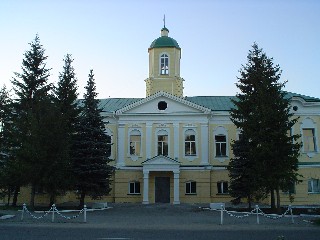 The building of the Guardhouse is a memorial of history and architecture. The construction started in 1781 in the northern part of a parade-ground of the second Omsk fortress, near from the Voskresensky dome (nowadays street Partizanskaya, 14). It took 4 years to build the Guardhouse. Its premises hosted the administration of the fortress, guardroom and rooms for those soldiers who misbehaved. The first educational institute of Omsk – Omsk Asian School which trained interpreters of Tatar, Manzhu and Tibetian languages for communication with Asian peoples was situated at the 2nd floor of this building in 1789-1804. In 1804 the school was moved to the building of military gymnasia. Afterwards the Guardhouse was used to keep state prisoners. As one of prisoners recollects “it was the only liberal guardhouse in Russia... Cells were locked only in the beginning of our sentence there, later they were open all day and locked only during the night. There were occasions that my friends would leave stealthly to visit someone in the city or just to have a beer”. The building of the Guardhouse is a memorial of history and architecture. The construction started in 1781 in the northern part of a parade-ground of the second Omsk fortress, near from the Voskresensky dome (nowadays street Partizanskaya, 14). It took 4 years to build the Guardhouse. Its premises hosted the administration of the fortress, guardroom and rooms for those soldiers who misbehaved. The first educational institute of Omsk – Omsk Asian School which trained interpreters of Tatar, Manzhu and Tibetian languages for communication with Asian peoples was situated at the 2nd floor of this building in 1789-1804. In 1804 the school was moved to the building of military gymnasia. Afterwards the Guardhouse was used to keep state prisoners. As one of prisoners recollects “it was the only liberal guardhouse in Russia... Cells were locked only in the beginning of our sentence there, later they were open all day and locked only during the night. There were occasions that my friends would leave stealthly to visit someone in the city or just to have a beer”.
This is the oldest remaining stone building of Omsk and one of the best examples of late baroque epoque in Siberia.
It is currently occupied by the Regional military registration and enlistment office.
|
|
 |
|
|





 The spit – the place where Omsk was founded.
The spit – the place where Omsk was founded. Kolchak’s house
Kolchak’s house Kondraty Belov’s museum
Kondraty Belov’s museum  The Cossack Nikolsky Cathedral
The Cossack Nikolsky Cathedral Omsk Military School
Omsk Military School Governor-general palace.
Governor-general palace.  Hillock Iliinskaya
Hillock Iliinskaya Chapel Serafimo-Alekseevskaya
Chapel Serafimo-Alekseevskaya Plumber Stepan
Plumber Stepan Lyuba. Lyubochka, Lyubasha.
Lyuba. Lyubochka, Lyubasha. The Vrubel Museum of Fine Arts
The Vrubel Museum of Fine Arts Omsk Drama Theatre
Omsk Drama Theatre  Tara Gate
Tara Gate Before the Bolsheviks came to power, Omsk had the Center - the Omsk Dome and the nearby square. It was one of the most beautiful churches in Russia. But the Barbarians had no mercey and it was destroyed in the 30-ies. So, Omsk lost its Center.
Before the Bolsheviks came to power, Omsk had the Center - the Omsk Dome and the nearby square. It was one of the most beautiful churches in Russia. But the Barbarians had no mercey and it was destroyed in the 30-ies. So, Omsk lost its Center. An unusual building of cylindrical form is well within view from the points of the drama theatre and the museum.
An unusual building of cylindrical form is well within view from the points of the drama theatre and the museum. Pushkin Library
Pushkin Library  A riddle to the present day
A riddle to the present day  The Tobolsk Gate
The Tobolsk Gate  Monument of Mother and World War II Museum
Monument of Mother and World War II Museum  Dostoevsky Museum
Dostoevsky Museum The organ hall was opened in the building of The Cossack Nikolsky Cathedral in 1983. This helped to prevent this building from destruction. The famous Czech company “Riger Closs” made an instrument consisting of 3700 pipes which was called “Opus 504”. There are no more than 50 organs in Russia and Omsk organ is regarded as one of the best among them. Many very famous musicians performed in Omsk organ hall – Harry Grotberg, Oleg Yanchenko, soloists Dmitry Khvorostovsky, Maria Bieshu.
The organ hall was opened in the building of The Cossack Nikolsky Cathedral in 1983. This helped to prevent this building from destruction. The famous Czech company “Riger Closs” made an instrument consisting of 3700 pipes which was called “Opus 504”. There are no more than 50 organs in Russia and Omsk organ is regarded as one of the best among them. Many very famous musicians performed in Omsk organ hall – Harry Grotberg, Oleg Yanchenko, soloists Dmitry Khvorostovsky, Maria Bieshu.  The building of court establishments is situated in the centre of the city, near Bankovsky lane and Alekseeva street (former Sobornaya square). It was built according to the academician Prusakov’s project. The construction began in 1916 (at the same time the monument to the tsar Alexander the III, who undertook the judicial reform, was laid nearby) and lasted for 3 years. The building was supposed to host different legal institutes but it was hardly ever used for that. Only in 1919 the Ministry of Justice of the Temporary All-Russian government and the Senat worked here. During the Soviet era it was used by Siberian Revolutionary Commitee (the Supreme govermental body in Siberia) and other Soviet and communistic institutions. Presently this is the building of the Regional parliament.
The building of court establishments is situated in the centre of the city, near Bankovsky lane and Alekseeva street (former Sobornaya square). It was built according to the academician Prusakov’s project. The construction began in 1916 (at the same time the monument to the tsar Alexander the III, who undertook the judicial reform, was laid nearby) and lasted for 3 years. The building was supposed to host different legal institutes but it was hardly ever used for that. Only in 1919 the Ministry of Justice of the Temporary All-Russian government and the Senat worked here. During the Soviet era it was used by Siberian Revolutionary Commitee (the Supreme govermental body in Siberia) and other Soviet and communistic institutions. Presently this is the building of the Regional parliament.  The building of the Guardhouse is a memorial of history and architecture. The construction started in 1781 in the northern part of a parade-ground of the second Omsk fortress, near from the Voskresensky dome (nowadays street Partizanskaya, 14). It took 4 years to build the Guardhouse. Its premises hosted the administration of the fortress, guardroom and rooms for those soldiers who misbehaved. The first educational institute of Omsk – Omsk Asian School which trained interpreters of Tatar, Manzhu and Tibetian languages for communication with Asian peoples was situated at the 2nd floor of this building in 1789-1804. In 1804 the school was moved to the building of military gymnasia. Afterwards the Guardhouse was used to keep state prisoners. As one of prisoners recollects “it was the only liberal guardhouse in Russia... Cells were locked only in the beginning of our sentence there, later they were open all day and locked only during the night. There were occasions that my friends would leave stealthly to visit someone in the city or just to have a beer”.
The building of the Guardhouse is a memorial of history and architecture. The construction started in 1781 in the northern part of a parade-ground of the second Omsk fortress, near from the Voskresensky dome (nowadays street Partizanskaya, 14). It took 4 years to build the Guardhouse. Its premises hosted the administration of the fortress, guardroom and rooms for those soldiers who misbehaved. The first educational institute of Omsk – Omsk Asian School which trained interpreters of Tatar, Manzhu and Tibetian languages for communication with Asian peoples was situated at the 2nd floor of this building in 1789-1804. In 1804 the school was moved to the building of military gymnasia. Afterwards the Guardhouse was used to keep state prisoners. As one of prisoners recollects “it was the only liberal guardhouse in Russia... Cells were locked only in the beginning of our sentence there, later they were open all day and locked only during the night. There were occasions that my friends would leave stealthly to visit someone in the city or just to have a beer”.